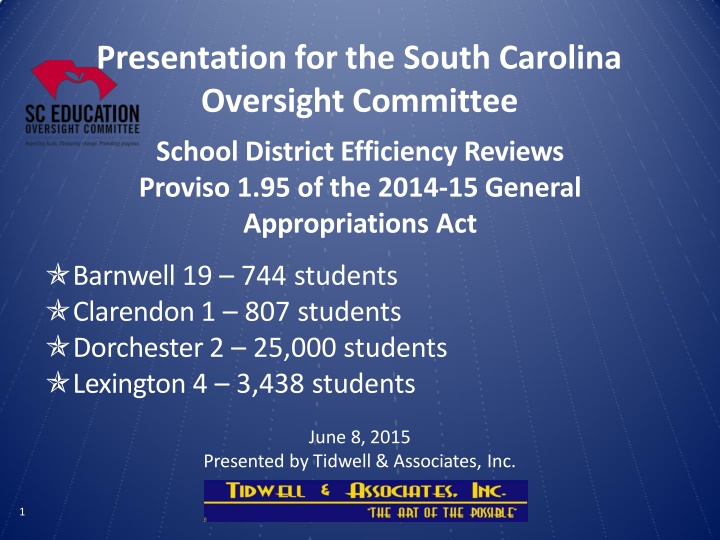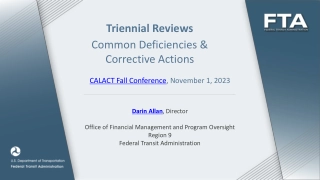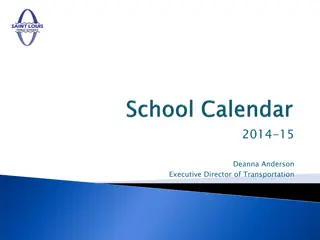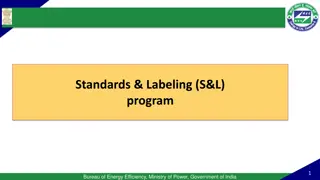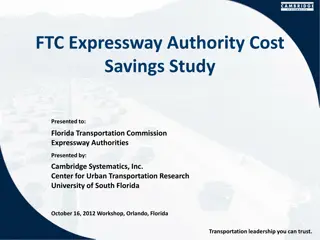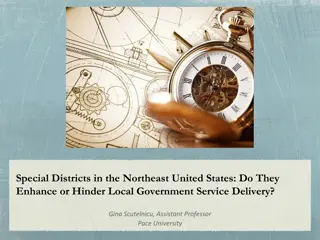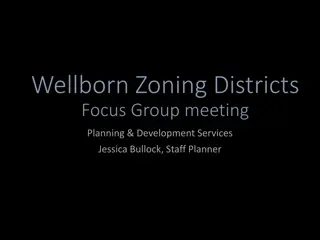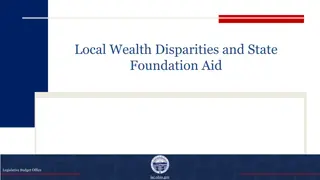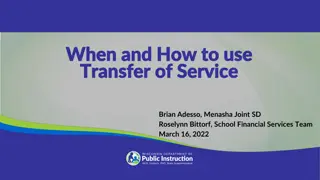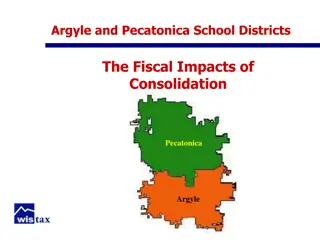Efficiency Reviews for SC School Districts - Recommendations & Savings
Presentation detailing efficiency reviews conducted by Tidwell & Associates for South Carolina school districts, with commendations, recommendations, estimated savings, and methodology explained.
Download Presentation

Please find below an Image/Link to download the presentation.
The content on the website is provided AS IS for your information and personal use only. It may not be sold, licensed, or shared on other websites without obtaining consent from the author.If you encounter any issues during the download, it is possible that the publisher has removed the file from their server.
You are allowed to download the files provided on this website for personal or commercial use, subject to the condition that they are used lawfully. All files are the property of their respective owners.
The content on the website is provided AS IS for your information and personal use only. It may not be sold, licensed, or shared on other websites without obtaining consent from the author.
E N D
Presentation Transcript
Presentation for the South Carolina Oversight Committee School District Efficiency Reviews Proviso 1.95 of the 2014-15 General Appropriations Act Barnwell 19 744 students Clarendon 1 807 students Dorchester 2 25,000 students Lexington 4 3,438 students June 8, 2015 Presented by Tidwell & Associates, Inc. 1
I. II. OVERVIEW OF TIDWELL AND ASSOCIATESAND TEAM III. OVERVIEW OF REVIEW METHODOLOGY IV. DISTRICT COMMENDATIONS/ RECOMMENDATIONS V. FISCAL IMPACTS FOR EACH DISTRICT VI. GLOBAL ISSUES FOUND ACROSSDISTRICTS VII.SUGGESTED NEXT STEPS FOR ADDITIONAL REVIEWS PRESENTATION OVERVIEW 2
Tidwell & Associates, Inc (Columbia-based firm) 28 year history of providing evaluation, reviews, studies (nationwide) Local, state, and federal experience Team Composition Total of 12 Consultants Team Leads: Mr. Ritchie Tidwell- Quality Control Dr. JoAnn Cox-Project Director /District Organization andManagement Dr. Tom Houlihan-Technical Advisor Our other experts in school district operationsincluded: In and out-of-stateexperts; 3 team members worked previously as department heads at the SC DOE; Former award winning superintendents, principals, andteachers; Policy advisors for SCgovernors; Twoattorneys; Certified public accountants;and Chief technologyofficers. 3
Methodology Review of Existing Data Peer District Comparisons (Agreed upon withEOC, district, and Tidwell and Assoc.) Preliminary Review Staff Surveys Onsite Review 12 consultants conducted the reviews Interviews, focus groups with staff and board members Site visits to districtschools Community Open House 4
Total District Commendations/Recommendations Barnwell 19 22 Commendations/ 62 Recommendations Clarendon 1 31 Commendations/ 48 Recommendations Dorchester 2 22 Commendations/ 60 Recommendations Lexington 4 37 Commendations/ 70 Recommendations 5
TOTAL FIRST -YEAR ESTIMATED SAVINGS -4 SC DISTRICTS $1,618,466 TOTAL FIVE-YEAR ESTIMATED SAVINGS 4 SC DISTRICTS $11,784,684 SINCE 2003, VIRGINIA STATEWIDE EFFICIENCY REVIEW PROGRAM OF 41 DISTRICTS ANNUAL ACTUAL SAVINGS $44,934,442 6
Five Year Savings/Costs By District and OperationalArea Dorchester 2 Lexington 4 Barnwell19 Clarendon 1 OperationalAreas Reviewed Total 5 year Savings/Costacross all districts by operational area Organization& Management FinancialManagement $2,205,600 ($189,050) ($249,750) $450 $1,767,250 $45,816 ($30,939) ($39,100) $12,661 ($11,562) Human Resources Facility Use &Energy Management Transportation ($243,475) ($2,500) $673,785 $109,110 $536,920 $3,405,795 ($264,791) ($443,000) $128,929 $2,826,933 $274,000 $126,473 ($66,162) $70,608 $404,919 Food Services Technology Grand Total5-year savings $2,513,544 $1,136,494 $100,000 $691,300 $1,633,033 $81,470 ($9,700) $114,083 $4,236,877 $2,023,347 $11,784,684 $9,337,774 $460,493 $1,590,276 $426,141 *Note: Three of the four districts are not requesting the maximum revenue annually permitted by state law. The additional funding would, among other things, help to pay for some of our recommendations that require costs. For example, based on FY 14-15, in Lexington 4, the foregone revenue was $149,914.99. If the school board does not subsequently impose a millage increase, then over a five-year period the foregone revenue total is $749,574.95 7
District Organization and Management (SELECTED GLOBAL FINDINGS/FUTURECONSIDERATION) Need to study and consider shared central office services of the smaller, rural districts. Need for a statewide analysis of the use and resources provided by the state s consortia; these appear to be an untapped resource (i.e., Pee Dee Education Center in Florence and the Western Piedmont Education Consortium in Greenwood, and Old English Consortium.) Lack of consistency in the evaluation of superintendents although there is a best practice model offered by the South Carolina School Boards Association (SCSBA) . 8
District Organization and Management (SELECTED GLOBAL FINDINGS/FUTURECONSIDERATION) The role and cost-effectiveness of county boards of education needs to be reviewed/studied at the local level. (ie., the county board that oversees the multiple Clarendon districts called the Clarendon Board of Education and the Anderson & Dillon Boards of Education) There is inconsistency in the monthly stipend for school board members. No pay up to $600 a month; more for board chairs Stronger training for Board members is needed particularly in understanding their roles as policymakers. 9
District Organization and Management (SELECTED GLOBAL FINDINGS/FUTURECONSIDERATION) The state collects districts strategic plans prior to the districts receiving their state student testing data (PASS). Plans are typically based on student academic needs. Plans should be submitted to the state after districts have had an opportunity to study their current test scores. Districts report that there are no state expectations for districts Response to Intervention program(RtI). 10
Financial Management (SELECTED GLOBAL FINDINGS/FUTURECONSIDERATION) All of the 4 districts could use an independent review of their insurance coverage. 2 of the 4 districts were not taking full advantage of their 8% borrowing capacity to fund capital improvements. There is a need for districts to study Medicaid reimbursements each fiscal year for opportunities to increase the amounts received. 11
Human Resources (SELECTED GLOBAL FINDINGS/FUTURECONSIDERATION) The state should consider incorporating professional training opportunities into Center for Educator Recruitment, Retention, and Advancement (CERRA) for both teachers and non-instructional personnel. Small districts would benefit from timely information on Family Medical Leave Act (FMLA) and Affordable Care Act (ACA) and current technology trends in software and instruction. Extend the mentorship program for an additional year for teachers. The key years for retaining talent is 2-5; support for teachers in those still developing years should be provided. Implement a formal strategic succession plan. Districts must be prepared for the expiration of the Teacher and Employee Retention Incentive (TERI) on June 30, 2018 and the impending retirement of baby boomers. Formal succession planning will help districts to retain knowledge and identify leadership gaps in their districts. 12
Facilities & Energy Management (SELECTED GLOBAL FINDINGS/FUTURECONSIDERATION) Three of the four districts do not have a five- year master plan. Two of the four districts do not have the staff knowledge required to determine energy conservation and efficiency measures and how to perform preventative maintenance on the HVAC equipment to reduce excessive energy use and costly equipment failures. Two of the four districts do not calculate current and projected enrollment capacity and utilization rates by school or grade-levels. 17
Facilities & Energy Management (SELECTED GLOBAL FINDINGS/FUTURECONSIDERATION) Three of the four districts had an extended warranty contract with HARRIS Integrated Solutions to maintain and support their building automation system , but were unaware that the contract provided low-cost/free services HARRIS has available for energy conservation and efficiency measures. Two of the four districts had a large backlog of deferred maintenance resulting in excessive energy use, frequent repairs of aging HVAC equipment , and reoccurring roofing leaks. Reportedly slow response time from the Office of School Facilities (OSF) at the State Department of Education is delaying school construction. 18
Transportation (SELECTED GLOBAL FINDINGS/FUTURECONSIDERATION) The training, staffing and facility requirements to have asafe and effective school transportation program are not synonymous with school districts that have less than 800 students. School districts are not taking advantage of state programs that offer reduced pricing for fuel. Districts are not competitively procuring vehicle maintenance, repair, and inspection services; instead they are supporting local vehicle services businesses for these services at often much higherprices. 19
Transportation (SELECTED GLOBAL FINDINGS/FUTURECONSIDERATION) Small districts, less than 40 buses, should utilize technical assistance offered by the SDE Office of Transportation. Small districts do not manage their vehicle preventive maintenance effectively. Districts contracting for transportation services should always retain district staff with the expertise to constantly monitor contract compliance and district needs. 20
Food Services (SELECTED GLOBAL FINDINGS/FUTURECONSIDERATION) The state of South Carolina purchasing consortium has been successful in helping districts secure quality food products at reasonable cost. However, all of the districts can benefit from assistance with menu development. Smaller districts demonstrated difficulty in securing or making use of menu analysis, & inventory or point of sales software. 21
Technology Management (SELECTED GLOBAL FINDINGS/FUTURECONSIDERATION) Districts are not maximizing their E-Rate Federal Program discounts which provides opportunities for schools and libraries to obtain discounts for services related to delivery of Internet and networks in schools. 22
Other states have similar statewide school district efficiency review programs COMMONWEALTH OF VIRGINIA STATEWIDE EFFICIENCY PROGRAM http://www.doe.virginia.gov/school_finance/efficiency_reviews/index.shtml TEXAS LEGISLATIVE BUDGET BOARD EFFICIENCY AUDITS http://www.lbb.state.tx.us/TeamPage.aspx?Team=SchoolPerfRev WEST VIRGINIA STATEWIDE EFFICIENCY REVIEW PROGRAM http://www.governor.wv.gov/Pages/Search.aspx?q=efficiency WASHINGTON STATE AUDITOR S EFFICIENCY AUDITS http://portal.sao.wa.gov/ReportSearch/Home/ViewReportFile?arn=1000004&isFindin g=false&sp=false OKLAHOMA SCHOOL PERFORMANCE REVIEW http://www.ok.gov/oeqa/Oklahoma_School_Performance_Review/ 23
FUTURE EFFICIENCY REVIEW STUDY RECOMMENDATIONS Include curriculum and instruction/special programs Include food services Work with the SC Department of Education to keep In$ite data updated (most recent is 2011-12) Work with the SC Department of Education on pre-planning of onsitevisits 24
FUTURE EFFICIENCY REVIEW STUDY RECOMMENDATIONS Consider parts of various other state s models to create one unique to SC (i.e., Virginia s 50 % implementation rule or pay back 25% cost of the study) Consider creating review protocols specific to SC school districts Consider setting up a statewide best practices database 25
Questions and Answers Ritchie Tidwell, Tidwell & Associates, Inc. 803-772-8985, tidwell@grantmaster.org JoAnn Cox, JJC & Associates 850-284-2945, jjcandassociates@gmail.com 26
